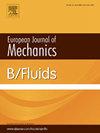The effects of non-uniform internal heating on the convective instability of power-law fluid-saturating-porous layer
IF 2.5
3区 工程技术
Q2 MECHANICS
引用次数: 0
Abstract
The onset of convection in a porous plate with non-Newtonian saturating fluid is studied using linear stability theory. The horizontal plate is heated internally by a heat source with varying strength along its vertical axis, a situation relevant to certain geophysical applications. Two distinct heating profiles are considered: a linearly antisymmetric distribution in Case and a quadratically symmetric distribution in Case . The non-Newtonian behavior of the saturating fluid is modeled using the power-law rheology in the Darcy–Forchheimer equation. An inclined throughflow is introduced at an angle to the horizontal direction. The eigenvalue problem is solved analytically using the Galerkin method of weighted residuals, and the results are verified numerically, via the 4th-order Runge–Kutta technique. The critical values of the internal Rayleigh number , wave number , and angular frequency for transverse and longitudinal rolls are affected by Peclet number , form drag coefficient , power law index , and non-uniformity coefficients and . The results relative to converge well to those relevant to uniform internal heating presented in the literature, serving as a benchmark for the two methods. According to the findings, the effect of the quadratic form drag number causes the critical values of shear-thinning fluids to converge to those of Newtonian fluids for both scenarios of stationary and oscillatory convection. This phenomenon is not observed for shear-thickening behavior. In addition, the change in the non-uniformity coefficients had a significantly larger impact on the critical values for a shear-thickening fluid than for a shear-thinning one, particularly in Case .
非均匀内加热对幂律流体饱和多孔层对流不稳定性的影响
用线性稳定性理论研究了含非牛顿饱和流体的多孔板对流的开始。水平板的内部由沿其垂直轴强度变化的热源加热,这种情况与某些地球物理应用有关。考虑了两种不同的加热剖面:情况a的线性反对称分布和情况b的二次对称分布。饱和流体的非牛顿行为使用达西-福奇海默方程中的幂律流变学建模。斜通流以与水平方向成ξ角引入。利用加权残差的伽辽金方法解析求解了特征值问题,并利用四阶龙格-库塔技术对结果进行了数值验证。横辊和纵辊内部瑞利数Ric、波数kc和角频率ωc的临界值受Peclet数Pe、形阻系数G、幂律指数n和非均匀性系数q1和q2的影响。相对于q1,2→0的结果与文献中有关均匀内加热的结果很好地收敛,可以作为两种方法的基准。结果表明,二次型阻力数G的影响使得剪切减薄流体在静对流和振荡对流两种情况下的临界值都收敛于牛顿流体的临界值。这种现象在剪切增厚行为中没有观察到。此外,非均匀性系数q1,2的变化对剪切增稠流体的临界值的影响明显大于剪切变薄流体,特别是在情况a中。
本文章由计算机程序翻译,如有差异,请以英文原文为准。
求助全文
约1分钟内获得全文
求助全文
来源期刊
CiteScore
5.90
自引率
3.80%
发文量
127
审稿时长
58 days
期刊介绍:
The European Journal of Mechanics - B/Fluids publishes papers in all fields of fluid mechanics. Although investigations in well-established areas are within the scope of the journal, recent developments and innovative ideas are particularly welcome. Theoretical, computational and experimental papers are equally welcome. Mathematical methods, be they deterministic or stochastic, analytical or numerical, will be accepted provided they serve to clarify some identifiable problems in fluid mechanics, and provided the significance of results is explained. Similarly, experimental papers must add physical insight in to the understanding of fluid mechanics.

 求助内容:
求助内容: 应助结果提醒方式:
应助结果提醒方式:


